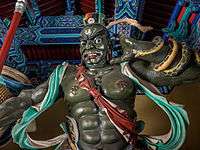Shunfeng'er
| Shunfeng'er | |||||||||
|
A statue of Shunfeng'er at Longde Temple in Tainan | |||||||||
| Traditional Chinese | 順風耳 | ||||||||
|---|---|---|---|---|---|---|---|---|---|
| Simplified Chinese | 顺风耳 | ||||||||
| Literal meaning | Wind-following Ear(s) | ||||||||
| |||||||||
| Wanli'er | |||||||||
| Traditional Chinese | 萬里耳 | ||||||||
| Simplified Chinese | 万里耳 | ||||||||
| Literal meaning | Myriad-Mile Ear(s) | ||||||||
| |||||||||
Shunfeng'er is a Chinese door god. He usually appears with Qianliyan as a guardian of the temples of the sea goddess Mazu.
Name
The name "Shunfeng'er" literally means "He with Ears that Follow the Wind" in reference to his ability to hear any sound carried upon the wind. The unusual idiom is translated variously as "Ears that Hear with the Wind",[1] "Ears that Hear what Comes on the Wind",[2] "Ears that Hear the Sounds Taken with the Wind",[3] "Wind-Accompanying Ears",[3] "Downwind Ears",[4] or even "Sharp Ears",[5] "Far-Hearing",[6] or "All-Hearing".[7] The god's role in helping sailors distinguish favorable winds also prompts the translations "Fair-Wind Ears"[3] and "Favorable-Wind Ears".[8][9]
It also appears as Shunfeng Er[1] and Shen Feng Er.[10] His partner Qianliyan's name similarly means "Sharp-Eyed" or "All-Seeing".
He is also sometimes known as Wanli'er,[11] which has similar meaning, as the Chinese word wàn—like the English "myriad"—simultaneously means the number 10,000 and "innumerable" or "uncountably vast".
Myths

Shunfeng'er's sharp hearing is employed to help sailors distinguish favorable winds from coming storms.[8] In some accounts, he is capable of hearing everything in the world, no matter how quietly spoken, and was therefore also worshipped as a witness and guarantor of oaths and contracts.[12]
Shunfeng'er is most often portrayed as a demon defeated and tamed or befriended by the sea goddess Mazu. By one account, he and Qianliyan appeared off Meizhou Island during a storm and were defeated by Mazu's magical silk scarf, which blew clouds of sand into their ears and eyes. After their submission, they pledged their loyalty when she kindly healed them of the damage she had caused them.[5] In another, the two were Song generals who competed for her hand at Peach Blossom Mountain (桃花山, Táohuā Shān) but were both defeated by her kung fu.[13] In another, the two were the brothers Gao Jue and Gao Ming. Ruthless generals, they fell at Peach Blossom Mountain and subsequently haunted it as demons. They appeared to Mazu when she traveled nearby and challenged her to battle, with the loser to do the winner's bidding. They intended to have her marry them both but were defeated by her magic and became her servants.[3][7] In still another, the Gao brothers were bandits during the Shang before they began to haunt the mountain.[8] In another, they were warriors or guards of King Zhou of Shang.[14]
He also appears as the "ears" of the Jade Emperor in the Ming-era Journey to the West.[7]
Legacy
Worship
Shunfeng'er most often appears as a door god at Mazuist temples[5] or as a guardian beside Mazu at her altars[1] or on her yellow paper charms.[15] He is separately worshipped in some villages[11] or by mariners for assistance avoiding danger. During the 8-day, 250-kilometer (155 mi) annual pilgrimages from Dajia to Beigang, Mazu's idol is accompanied by 10-foot (3 m) figures of Shunfeng'er and Qianliyan played by masked men on stilts.[2]
In art
Shunfeng'er typically appears as a red- or brown-skinned demon cupping a hand to one of his ears. He also occasionally appears with three heads and six arms.[3] He usually appears to the left of his companion Qianliyan. Sometimes Shunfeng'er appears as the green demon, in which case he usually has one horn and ruby eyes.[16]
References
Citations
- 1 2 3 Giuffrida, Noelle (2004), "Tianhou", Holy People of the World, Vol. II, Santa Barbara: ABC Clio.
- 1 2 Nadeau, Randall (2012), "Divinity", The Wiley-Blackwell Companion to Chinese Religions, Malden: Wiley-Blackwell, p. 375.
- 1 2 3 4 5 Masure, Yves, "Shun Feng Er", ThaiLex.
- ↑ Hanan, Patrick (2004), "The First Novel Translated into Chinese", Chinese Fiction of the Nineteenth and Early Twentieth Centuries, Masters of Chinese Studies, Vol. II, New York: Columbia University Press, p. 97.
- 1 2 3 Yuan (2006), p. 123–4.
- ↑ Ho Yi, "The Good, the Bad, and the Divine", Taipei Times.
- 1 2 3 Lobb, Fred (2011), "Mazu and General Sees All and General Hears All", Chinese Folktales, Hong Kong: Blogspot.
- 1 2 3 Baquet, James (2015), "Mazu's Consorts", Shenzhen Daily, Shenzhen.
- ↑ Eberhard, Wolfram; et al. (1986), "Ma-zu", Dictionary of Chinese Symbols, London: Routledge & Kegan Paul.
- ↑ Guardian of the South Seas: Thian Hock Keng and Singapore Hokkien Huay Kuan, Singapore, 2006, p. 28.
- 1 2 Dean (2010), p. 147.
- ↑ The Boxer Codex, Leiden: Koninklijke Brill, 2016, p. 644.
- ↑ Devonshire-Ellis, Chris (2008), "Mazu: The Princess of Tides", China Expat, Asia Briefing.
- ↑ "A Guide to Qing'an Guild Hall", Official site, Ningbo: East Zhejiang Maritime Affairs Folk Custom Museum, 2010.
- ↑ Soo (1990), p. 41.
- ↑ Ruitenbeek (1999), p. 319.
Bibliography
- Dean, Kenneth; et al. (2010), Ritual Alliances of the Putian Plain, Vol. II, Handbook of Oriental Studies, §4: China, Vol. 23/2, Leiden: Brill.
- Ruitenbeek, Klaas (1999), "Mazu, Patroness of Sailors, in Chinese Pictorial Art", Artibus Asiae, Vol. 58, No. 3/4, pp. 281–329.
- Soo Khin Wah (1990), "The Cult of Mazu in Peninsular Malaysia", The Preservation and Adaption of Tradition: Studies of Chinese Religious Expression in Southeast Asia, Contributions to Southeast Asian Ethnography, No. 9, Columbus: OSU Department of Anthropology, pp. 29–51.
- Yuan Haiwang (2006), "Mazu, Mother Goddess of the Sea", The Magic Lotus Lantern and Other Tales from the Han Chinese, World Folklore Series, Westport: Libraries Unlimited.